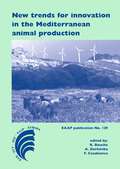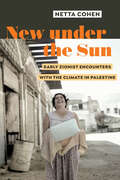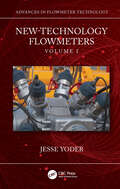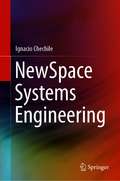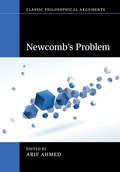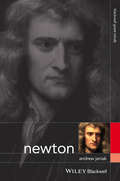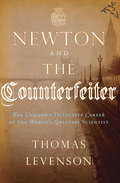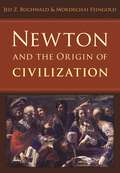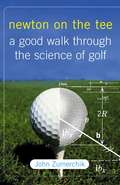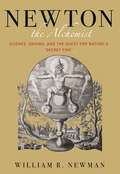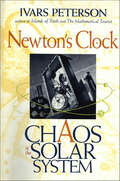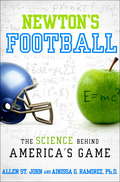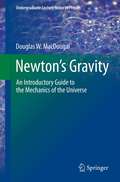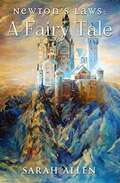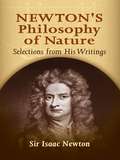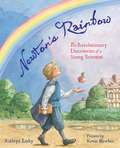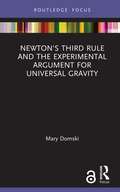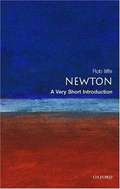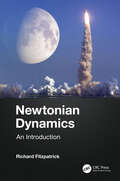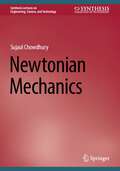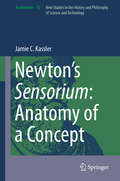- Table View
- List View
New and Future Development in Biopesticide Research: Biotechnological Exploration
by Surajit De Mandal Fengliang Jin G. Ramkumar S. KarthiThis book discusses different approaches for successful pest-management through biotechnological interventions. Pest management is directly associated with the agricultural productivity. The book introduces the reader to various kinds of biopesticides that have been developed and are being developed for field application. Chemical pesticides have been widely used to control pests, and these induce pesticide resistance as well as other environmental problems. This book discusses the necessity to develop alternate pest control strategies, especially environment-friendly and target-specific biopesticides against destructive pests. The book describes important aspects such as microbial biopesticides, plant-based biopesticides, natural products that act against pests and the various other biotechnological advances and limitations of these biopesticides. It provides an in-depth knowledge of the latest research and development in the area of biopesticides. This informative book is meant for students and researchers in the fields of biotechnology, agriculture and applied microbiology.
New trends for innovation in the Mediterranean animal production
by A. Derkimba F. Casabianca R. BoucheThe Mediterranean area shows a great diversity of livestock systems, depending on local resources and traditions, but also on the networking space where informational resources are available for producers. During the last decades, a lot of innovations have been conceived or introduced in the Mediterranean area, allowing livestock systems to remain competitive. The book looks at two main issues: firstly, it gives an updated review on the main innovations that significantly changed the activities of livestock production in the Mediterranean area in the recent past. Secondly, the focus lies on the extent to which these innovations improve the efficiency, ensure the socio-cultural basis or reduce the environmental impact of livestock systems. One major finding is a new vision of innovating systems based on the distinction between regulated innovation (when aims are fixed) and innovative design (when aims are questioned). Innovations reported in the book are dealing with a set of concerns. They concern the production techniques, the work organization, the equipment and infrastructures, the collective features for selection, reproduction, feeding or sanitary devices. They also concern the local organization such as product labelling, new dynamics around local breeds, collective rules for supply basin or approaches of new products for new markets. More recently, some innovations focus on environmental impacts of livestock production, due to an increasing consciousness of those kinds of problems. In the final part of the book, a round table copes with a crucial question: are traditions in Mediterranean livestock activities to be considered an obstacle or a source of innovation? This book provides a set of updated information and knowledge useful for researchers, students, extension services and policy-makers in the field of animal science.
New under the Sun: Early Zionist Encounters with the Climate in Palestine
by Dr. Netta CohenNew under the Sun explores Zionist perceptions of—and responses to—Palestine’s climate. From the rise of the Zionist movement in the late 1890s to the establishment of the State of Israel in 1948, Netta Cohen traces the production of climactic knowledge through a rich archive that draws from medicine and botany, technology and economics, and architecture and planning. As Cohen convincingly argues, this knowledge was not only shaped by Jewish settlers’ Eurocentric views but was also indebted to colonial practices and institutions. Zionists’ claims to the land were often based on the construction of Jewish settlers as natives, even while this was complicated by their alienated responses to Palestine’s climate. New under the Sun offers a highly original environmental lens on the ways in which Zionism’s spatial ambitions and racial fantasies transformed the lives of humans and nonhumans in Palestine.
New-Technology Flowmeters: Volume I
by Jesse YoderNew-Technology Flowmeters describes the origin, principle of operation, development, advantages and disadvantages, applications, and frontiers of research for new-technology flowmeters, which include Coriolis, magnetic, ultrasonic, vortex, and thermal. Focusing on the newer, faster growing flowmeter markets, the book places them in the context of more traditional meters such as differential pressure, turbine, and positive displacement. Taking an objective look at the origins of each flowmeter type, the book discusses the early patents, for each type, and which companies deserve credit for initially commercializing each flowmeter type. This book is designed for personnel involved with flowmeters and instrumentation, including product and marketing managers, strategic planners, application engineers, and distributors.
NewSpace Systems Engineering
by Ignacio ChechileThis book provides a guide to engineering successful and reliable products for the NewSpace industry. By discussing both the challenges involved in designing technical artefacts, and the challenges of growing an organisation, the book presents a unique approach to the topic.New Space Systems Engineering explores numerous difficulties encountered when designing a space system from scratch on limited budgets, non-existing processes, and great deal of organizational fluidity and emergence. It combines technical topics related to design, such as system requirements, modular architectures, and system integration, with topics related to organizational design, complexity, systems thinking, design thinking and a model based systems engineering. Its integrated approach mean this book will be of interest to researchers, engineers, investors, and early-stage space companies alike. It will help New Space founders and professionals develop their technologies and business practices, leading to more robust companies and engineering development.
Newcomb's Problem (Classic Philosophical Arguments)
by Arif AhmedNewcomb's problem is a controversial paradox of decision theory. It is easily explained and easily understood, and there is a strong chance that most of us have actually faced it in some form or other. And yet it has proven as thorny and intractable a puzzle as much older and better-known philosophical problems of consciousness, scepticism and fatalism. It brings into very sharp and focused disagreement several long-standing philosophical theories on practical rationality, on the nature of free will, and on the direction and analysis of causation. This volume introduces readers to the nature of Newcomb's problem, and ten chapters by leading scholars present the most recent debates around the problem and analyse its ramifications for decision theory, metaphysics, philosophical psychology and political science. Their chapters highlight the status of Newcomb's problem as a live and continuing issue in modern philosophy.
Newton
by Andrew JaniakNewton is an evocative intellectual history of the life and ideas of Isaac Newton the natural philosopher, covering his influential thoughts about philosophical problems, our knowledge of nature, and even the nature of the divine. Offers a comprehensive and highly accessible introduction to the life and ideas of Isaac Newton, emphasizing his influential contributions to the field of philosophy Covers the principal philosophical topics that captivated Newton's mind, from our knowledge of nature to the nature of the divine Includes the most recent and innovative research regarding Newton's views on theology and philosophy Emphasizes the philosophical importance of Newton's work to the history of philosophy and his engagement with the ideas of both historic and contemporary figures such as Galileo and Descartes, Leibniz and Locke
Newton and the Counterfeiter: The Unknown Detective Career of the World's Greatest Scientist
by Thomas LevensonA &“thoroughly surprising&” chapter in the life of Isaac Newton, with a &“vivid re-creation of 17th-century London and its fascinating criminal haunts&” (Providence Journal). When renowned scientist Isaac Newton takes up the post of Warden of His Majesty&’s Mint in London, another kind of genius—a preternaturally gifted counterfeiter named William Chaloner—has already taken up residence in the city, rising quickly in an unruly, competitive underworld. In the courts and streets of London, and amid the tremors of a world being transformed by ideas Newton himself set in motion, Chaloner crosses paths with the formidable new warden. An epic game of cat and mouse ensues in Newton and the Counterfeiter, revealing for the first time the &“remarkable and true tale of the only criminal investigator who was far, far brainier than even Sherlock Holmes: Sir Isaac Newton during his tenure as Warden of the Royal Mint . . . A fascinating saga&” (Walter Isaacson). &“I absolutely loved Newton and the Counterfeiter. Deft, witty and exhaustively researched.&” —Junot Díaz, author of The Brief Wondrous Life of Oscar Wao &“A delicious read, featuring brilliant detective work and a captivating story . . . A virtuoso performance.&” —Sylvia Nasar, author of A Beautiful Mind &“Through a page-turning narrative, we witness Isaac Newton&’s genius grappling with the darker sides of human nature, an all too human journey reflecting his deepest beliefs about the cosmic order.&” —Brian Greene, author of The Fabric of the Cosmos &“Levenson transforms inflation and metallurgy into a suspenseful detective story bolstered by an eloquent summary of Newtonian physics and stomach-turning descriptions of prison life in the Tower of London. . . . [The book] humanizes a legend, transforming him into a Sherlock Holmes in pursuit of his own private Moriarty.&” —The Washington Post
Newton and the Origin of Civilization
by Jed Z. Buchwald Mordechai FeingoldIsaac Newton's Chronology of Ancient Kingdoms Amended, published in 1728, one year after the great man's death, unleashed a storm of controversy. And for good reason. The book presents a drastically revised timeline for ancient civilizations, contracting Greek history by five hundred years and Egypt's by a millennium. Newton and the Origin of Civilization tells the story of how one of the most celebrated figures in the history of mathematics, optics, and mechanics came to apply his unique ways of thinking to problems of history, theology, and mythology, and of how his radical ideas produced an uproar that reverberated in Europe's learned circles throughout the eighteenth century and beyond. Jed Buchwald and Mordechai Feingold reveal the manner in which Newton strove for nearly half a century to rectify universal history by reading ancient texts through the lens of astronomy, and to create a tight theoretical system for interpreting the evolution of civilization on the basis of population dynamics. It was during Newton's earliest years at Cambridge that he developed the core of his singular method for generating and working with trustworthy knowledge, which he applied to his study of the past with the same rigor he brought to his work in physics and mathematics. Drawing extensively on Newton's unpublished papers and a host of other primary sources, Buchwald and Feingold reconcile Isaac Newton the rational scientist with Newton the natural philosopher, alchemist, theologian, and chronologist of ancient history.
Newton on the Tee
by John ZumerchikLike no other sport, golf obsesses those poor souls who hope to master its subtleties and abundant complexities. One shot is hit like a dream, the next a nightmare. As a result, the game's disciples have embraced any and all techniques endorsed by pros and hackers, poets and philosophers (these days a good walk is often spoiled by tripping over a sandtrap's worth of Zen meditations and mystical tomes). But while so many have journeyed through golf's metaphysics, no one has presented a readable, compelling look at the science of the game -- until now. In Newton on the Tee, accomplished science writer John Zumerchik examines, explores, and explains to us the endless details that make golf such a tantalizing pursuit. Written in language accessible to even the most scientifically disinclined, Zumerchik's book delves into areas of supreme importance to every golfer, including: The Physics of the Sweet Swing: The universal principles shared by all those rhythmic and well-timed swings you see on TV but not in the mirror Mind Over Muscle: How the brain affects and controls the movements of the body (and why confidence is the golfer's most indispensable tool) Getting the Ball from Here to There: Decoding the vagaries of launch angles, spin, lift, and gravity that make the difference between walking happily down the fairway and tramping into the bunkers Probability and Statistics: Understanding the mathematics of golf, and a by-the-numbers appraisal of golf's greatest legends With a firm grasp of both his subject and his 7-iron, Zumerchik takes the reader through all these topics and more, in an entertaining and enlightening work that will give every golfer something to chew on besides his or her nails, and make clear and comprehensible the hundred-and-thirty-five things you shouldn't think about during your backswing.
Newton the Alchemist: Science, Enigma, and the Quest for Nature's "Secret Fire"
by William NewmanA book that finally demystifies Newton’s experiments in alchemyWhen Isaac Newton’s alchemical papers surfaced at a Sotheby’s auction in 1936, the quantity and seeming incoherence of the manuscripts were shocking. No longer the exemplar of Enlightenment rationality, the legendary physicist suddenly became “the last of the magicians.” Newton the Alchemist unlocks the secrets of Newton’s alchemical quest, providing a radically new understanding of the uncommon genius who probed nature at its deepest levels in pursuit of empirical knowledge.In this evocative and superbly written book, William Newman blends in-depth analysis of newly available texts with laboratory replications of Newton’s actual experiments in alchemy. He does not justify Newton’s alchemical research as part of a religious search for God in the physical world, nor does he argue that Newton studied alchemy to learn about gravitational attraction. Newman traces the evolution of Newton’s alchemical ideas and practices over a span of more than three decades, showing how they proved fruitful in diverse scientific fields. A precise experimenter in the realm of “chymistry,” Newton put the riddles of alchemy to the test in his lab. He also used ideas drawn from the alchemical texts to great effect in his optical experimentation. In his hands, alchemy was a tool for attaining the material benefits associated with the philosopher’s stone and an instrument for acquiring scientific knowledge of the most sophisticated kind.Newton the Alchemist provides rare insights into a man who was neither Enlightenment rationalist nor irrational magus, but rather an alchemist who sought through experiment and empiricism to alter nature at its very heart.
Newton's Apple and Other Myths about Science
by Ronald L. NumbersA falling apple inspired the law of gravity--or so the story goes. Is it true? Perhaps not. But why do such stories endure as explanations of how science happens? Newton's Apple and Other Myths about Science brushes away popular misconceptions to provide a clearer picture of scientific breakthroughs from ancient times to the present.
Newton's Clock: Chaos in the Solar System
by Ivars PetersonWith his critically acclaimed best-sellers The Mathematical Toursist and Islands of Truth, Ivars Peterson took readers to the frontiers of modern mathematics. His new book provides an up-to-date look at one of science's greatest detective stories: the search for order in the workings of the solar system.In the late 1600s, Sir Isaac Newton provided what astronomers had long sought: a seemingly reliable way of calculating planetary orbits and positions. Newton's laws of motion and his coherent, mathematical view of the universe dominated scientific discourse for centuries. At the same time, observers recorded subtle, unexpected movements of the planets and other bodies, suggesting that the solar system is not as placid and predictable as its venerable clockwork image suggests.Today, scientists can go beyond the hand calculations, mathematical tables, and massive observational logs that limited the explorations of Newton, Copernicus, Galileo, Kepler, Tycho Brahe, and others. Using supercomputers to simulate the dynamics of the solar system, modern astronomers are learning more about the motions they observe and uncovering some astonishing examples of chaotic behavior in the heavens. Nonetheless, the long-term stability of the solar system remains a perplexing, unsolved issue, with each step toward its resolution exposing additional uncertainties and deeper mysteries.To show how our view of the solar system has changed from clocklike precision to chaos and complexity, Newton's Clock describes the development of celestial mechanics through the ages--from the star charts of ancient navigators to the seminal discoveries of the 17th centure; from the crucial work of Poincaré to the startling, sometimes controversial findings and theories made possible by modern mathematics and computer simulations. The result makes for entertaining and provocative reading, equal parts science, history, and intellectual adventure.
Newton's Football
by Allen St. John Ainissa G. RamirezIn the bestselling tradition of Freakonomics and Scorecasting comes a clever and accessible look at the big ideas underlying the science of football. Did you hear the one about the MacArthur genius physicist and the NFL coach? It's not a joke. It's actually an innovative way to understand chaos theory, and the remarkable complexity of modern professional football. In Newton's Football, journalist and New York Times bestselling author Allen St. John and TED Speaker and former Yale professor Ainissa Ramirez explore the unexpected science behind America's Game. Whether it's Jerry Rice finding the common ground between quantum physics and the West Coast offense or an Ivy League biologist explaining--at a granular level--exactly how a Big Mac morphs into an outside linebacker, Newton's Football illuminates football--and science--through funny, insightful stories told by some of the world's sharpest minds. With a clear-eyed empirical approach--and an exuberant affection for the game--St. John and Ramirez address topics that have long beguiled scientists and football fans alike, including: * the unlikely evolution of the football (or, as they put it, "The Divinely Random Bounce of the Prolate Spheroid") * what Vince Lombardi has in common with Isaac Newton * how the hardwired behavior of monkeys can explain a head coach's reluctance to go for it on fourth-down * why a gruesome elevator accident jump-started the evolution of placekicking * how Teddy Roosevelt saved football using the same behavioral science concept that Dreamworks would use to save Shrek * why woodpeckers don't get concussions * how better helmets actually made the game more dangerous Every Sunday the NFL shares a secret with only its savviest fans: The game isn't just a clash of bodies, it's a clash of ideas. The greatest minds in football have always possessed an instinctual grasp of science, understanding the big ideas and gritty realities that inform the game's rich past, as well as its increasingly uncertain future. Blending smart reporting, counterintuitive creativity, and compelling narrative, Newton's Football takes gridiron analysis to the next level, giving fans a book that entertains, enlightens, and explains the game anew.Advance praise for Newton's Football "It was with great interest that I read Newton's Football. I'm a fan of applying of science to sport and Newton's Football truly delivers. The stories are as engaging as they are informative. This is a great read for all football fans."--Mark Cuban"Equal parts Isaac Newton and Cam Newton, this book is as thoroughly entertaining and engrossing as a fall Sunday afternoon on the couch."--L. Jon Wertheim, executive editor of Sports Illustrated and bestselling co-author of Scorecasting "Nothing is more bipartisan than America's love for football. And Newton's Football will unite readers of all stripes by merging science and sports in a fresh and fascinating fashion. Read this book and you'll never again watch a game the same way."--Chris Mooney, New York Times bestselling author of The Republican War on Science"A fascinating melding of science and sport, at once lively and illuminating, rich with knowledge of the game and arresting explanations of its winning strategies."--Daniel J. Kevles, Yale UniversityFrom the Hardcover edition.
Newton's Gravity
by Douglas W. Macdougal"Newton's Gravity" conveys the power of simple mathematics to tell the fundamental truth about nature. Many people, for example, know the tides are caused by the pull of the Moon and to a lesser extent the Sun. But very few can explain exactly how and why that happens. Fewer still can calculate the actual pulls of the Moon and Sun on the oceans. This book shows in clear detail how to do this with simple tools. It uniquely crosses disciplines - history, astronomy, physics and mathematics - and takes pains to explain things frequently passed over or taken for granted in other books. Using a problem-based approach, "Newton's Gravity" explores the surprisingly basic mathematics behind gravity, the most fundamental force that governs the movements of satellites, planets, and the stars. Author Douglas W. MacDougal uses actual problems from the history of astronomy, as well as original examples, to deepen understanding of how discoveries were made and what they mean. "Newton's Gravity" concentrates strongly on the development of the science of orbital motion, beginning with Galileo, Kepler, and Newton, each of whom is prominently represented. Quotes and problems from Galileo's Dialogs Concerning Two New Sciences and particularly Newton's Principia help the reader get inside the mind of those thinkers and see the problems as they saw them, and experience their concise and typically eloquent writing. This book enables students and curious minds to explore the mysteries of celestial motion without having to know advanced mathematics. It will whet the reader's curiosity to explore further and provide him or her the tools (mathematical or physical) to do so.
Newton's Laws: A Fairy Tale
by Sarah AllenSarah Allen is a fantasy novelist and professional math and physics tutor. In her Fairy Tale Physics series, Sarah has combined her talents into something you’ve never seen before. <p><p> Each Fairy Tale Physics book is a delightful illustrated story that introduces and explores physics concepts in a way that anyone can understand. <p><p> In Newton’s Laws: A Fairy Tale, you’ll read about young Kip, whose only inheritance from his father is a single apple. Always the optimist, Kip strikes out into the world to seek his fortune, and meets a wizard with mysterious plans… <p><p> Kip’s adventure is packed with situations that introduce us to some of the foundations of physics: Newton’s laws of motion. But not only will you learn physics alongside Kip – there’s a bonus section on problem solving at the end, with over 30 exercises that tie the lessons of the story concretely to what you might learn in a physics class in high school or college. Also included are links to Sarah’s favorite physics resources: videos, articles, and online simulations that you can play with to learn more. <p><p> Newton’s Laws: A Fairy Tale is for you if: <p> You are curious about physics. <p>You are a parent looking to introduce physics concepts to your child. <p>You are taking your first AP or college physics course. <p>You are intrigued by a fairy tale that holds something unique and special! <p><p>This is book one in the Fairy Tale Physics Series. It covers Newton's Three Laws, Free Body Diagrams, Net Force, Acceleration, and Forces. Enjoy!
Newton's Philosophy of Nature: Selections from His Writings
by Sir Isaac Newton H. S. ThayerAside from the Principia and occasional appearances of the Opticks, Newton's writings have remained largely inaccessible to students of philosophy, science, and literature as well as to other readers. This book provides a remedy with wide representation of the interests, problems, and diverse philosophic issues that preoccupied the greatest scientific mind of the seventeenth century.Grouped in sections corresponding to methods, principles, and theological considerations, these selections feature cross-references to related essays. Starting with an examination of the methods of natural philosophy--including the rules of reasoning, the formulation of hypotheses, and the experimental method--the essays explore the laws of motion and the relationships between God and gravity, creation, and universal design. Discussions of questions related to natural philosophy include theories on light, colors, and perceptions. The volume concludes with absorbing selections from the Opticks and a helpful series of historical and explanatory notes.
Newton's Rainbow: The Revolutionary Discoveries of a Young Scientist
by Kathryn LaskyThis book tells the story of young Isaac—always reading, questioning, observing, and inventing—and how he eventually made his way to Cambridge University, where he studied the work of earlier scientists and began building on their accomplishments. The book celebrates Newton's discoveries that illuminated the mysteries of gravity, motion, and even rainbows, discoveries that gave mankind a new understanding of the natural world, discoveries that changed science forever.
Newton's Third Rule and the Experimental Argument for Universal Gravity (Routledge Focus on Philosophy)
by Mary DomskiThis book provides a reading of Newton’s argument for universal gravity that is focused on the evidence-based, "experimental" reasoning that Newton associates with his program of experimental philosophy. It highlights the richness and complexity of the Principia and also draws important lessons about how to situate Newton in his natural philosophical context. The book has two primary objectives. First, it defends a novel interpretation of the third of Newton’s four Rules for the Study of Natural Philosophy – what the author terms the Two-Set Reading of Rule 3. Second, it argues that this novel interpretation of Rule 3 sheds additional light on the differences between Newton’s experimental philosophy and Descartes’s "hypothetical philosophy," and that it also illuminates how the practice of experimental philosophy allowed Newton to make a universal force of gravity the centerpiece of his explanation of the system of the world. Newton’s Third Rule and the Experimental Argument for Universal Gravity will be of interest to researchers and advanced students working on Newton’s natural philosophy, early modern philosophy, and the history of science.
Newton: A Very Short Introduction
by Robert IliffeNewton's reputation was the subject of intense debate long before his death in 1727. While alive, numerous opponents sought to topple his theories, and his views on religion were considered by many to be unorthodox. For the vast majority of scholars, however, his groundbreaking approach to science overrode all else. This book makes use of previously unpublished private writings and manuscript sources to present a concise exploration of the internal springs of Newton's complex character. Robert Iliffe describes Newton's studies in fields ranging from alchemy, physics, and mathematics, as well as his controversial religious beliefs, and concludes with a consideration of the legacy left after his demise. Newton will gratify readers who are interested in the real history behind one of the world's most legendary scientists.
Newtonian Dynamics: An Introduction
by Richard FitzpatrickThis textbook provides a comprehensive review of Newtonian dynamics at a level suitable for undergraduate physics students. It demonstrates that Newton’s three laws of motion, combined with a few simple force laws, can not only describe the motions of everyday objects observed on the surface of the Earth, but can also account for the motions of celestial objects seen in the sky. It helps bridge the problematic transition between elementary physics courses and upper-division physics course. The book will start off at a level suitable for undergraduate (freshman) physics students and will very gradually increase, until, towards the end, it will approach (but not quite reach) a level characteristic of a graduate (senior) physics course. Each chapter of the book will end with a large number of numerical and analytical exercises and, in all appropriate cases, the final answers to the exercises will be specified. The large number of exercises will allow students to accurately test their understanding of the material presented in the book, ideal for students who are self-studying or are taking classes remotely. Key features: Provides a brief and accessible introduction to a complex topic. Contains a thorough treatment of the motions of heavenly bodies than conventional elementary mechanics texts. Provides a wealth of end-of-chapter exercises to test understanding.
Newtonian Mechanics (Synthesis Lectures on Engineering, Science, and Technology)
by Sujaul ChowdhuryThis book discusses topics related to Newtonian mechanics and is ideal for a one semester course. Introductory topics are first presented including: time, space, and matter; different coordinate systems; vectors; and unit vectors;. The author presents tools such as displacement, velocity, and acceleration to describe projectile motion and uniform circular motion. Newton’s laws of motion and concepts of force and mass are discussed followed by kinetic energy, potential energy, and both conservative and non-conservative forces. This class-tested book also introduces angular displacement, angular speed, and angular acceleration as well as the use of these to describe the motion of particles with constant angular acceleration. Concepts of torque, angular momentum, and rotational inertia are presented to explain the motion of physical pendulum. Motion under central force is also covered and Kepler’s laws are derived.
Newtonian Physics
by Benjamin CrowellA volume in the open source textbook physics series Light and Matter.
Newton’s Sensorium: Anatomy of a Concept (Archimedes Ser. #53)
by Jamie C. KasslerThese chapters analyze texts from Isaac Newton’s work to shed new light on scientific understanding at his time. Newton used the concept of “sensorium” in writings intended for a public audience, in relation to both humans and God, but even today there is no consensus about the meaning of his term. The literal definition of the Latin term 'sensorium', or its English equivalent 'sensory', is 'thing that feels’ but this is a theoretical construct.The book takes readers on a process of discovery, through inquiry into both Newton’s concept and its underlying model. It begins with the human sensorium. This part of his concept is situated in the context of the aforesaid writings but also in the context of the writings of two of Newton's contemporaries, the physicians William Briggs and Thomas Willis, both of whom were at the forefront of their respective specialties of ophthalmology and neurology. Only once the human sensorium has been explored is it possible to generalize to the unobservable divine sensorium, because Newton's method of reasoning from experience requires that the second part of his concept is last in the order of knowledge. And the reason for this sequence is that his method, the short-hand term for which is 'analogy of nature', proceeds from that which has been observed to be universally true to that which is beyond the limits of observation. Consequently, generalization passes insensibly into reasoning by analogy.Readers will see how certain widespread assumptions can be called into question, such as that Newton was a theological voluntarist for whom the will is superior to the intellect, or that, for Newton, not only the world or universe but also God occupies the whole extent of infinite space. The insights afforded through this book will appeal to scholars of the philosophy of science, human physiology, philosophy of mind and epistemology, among others.

